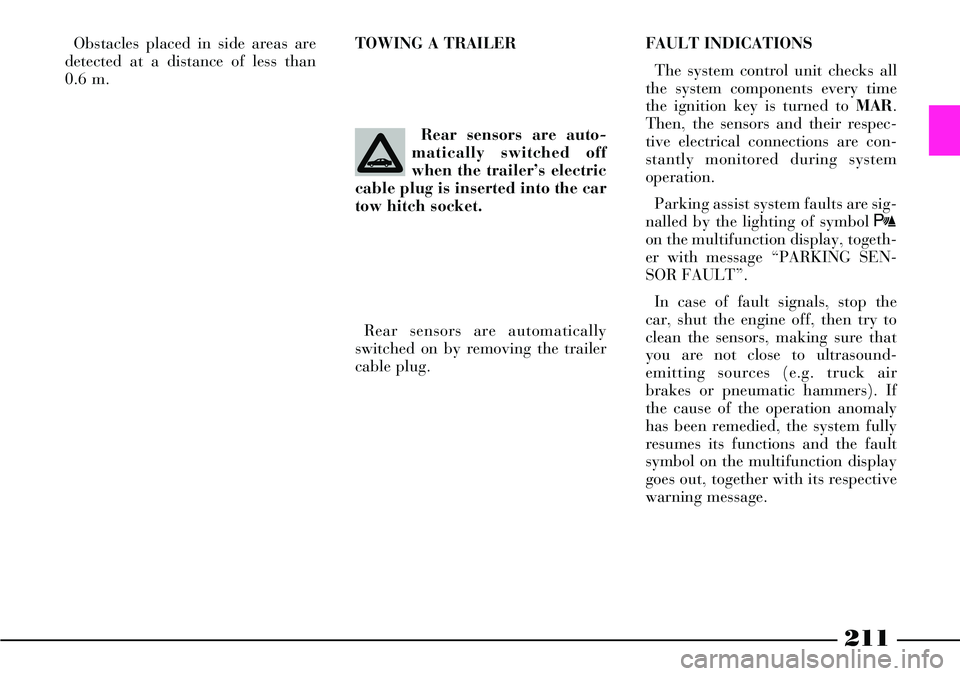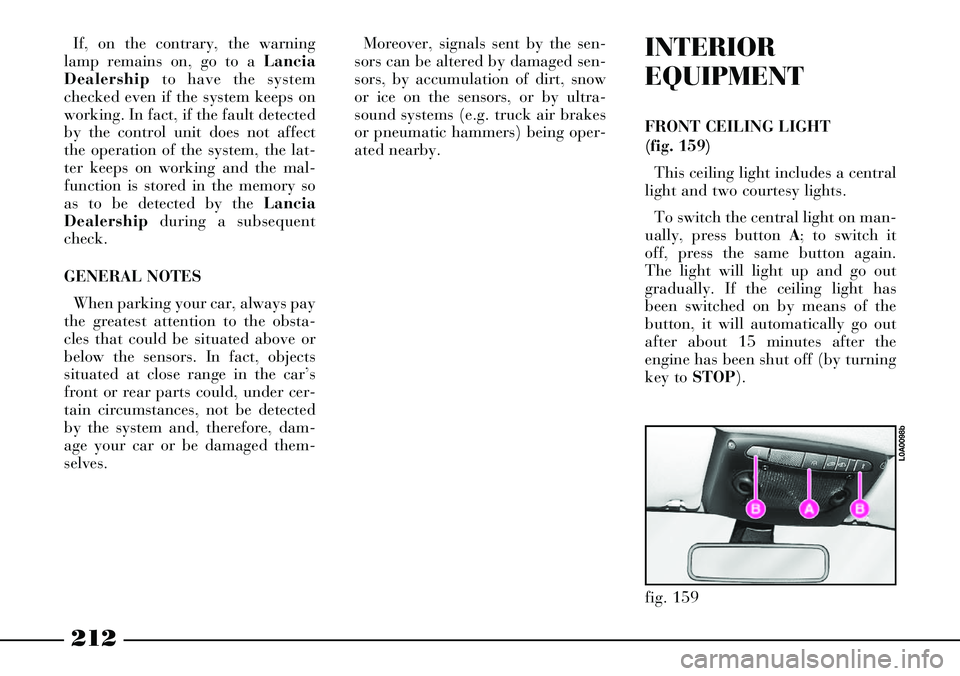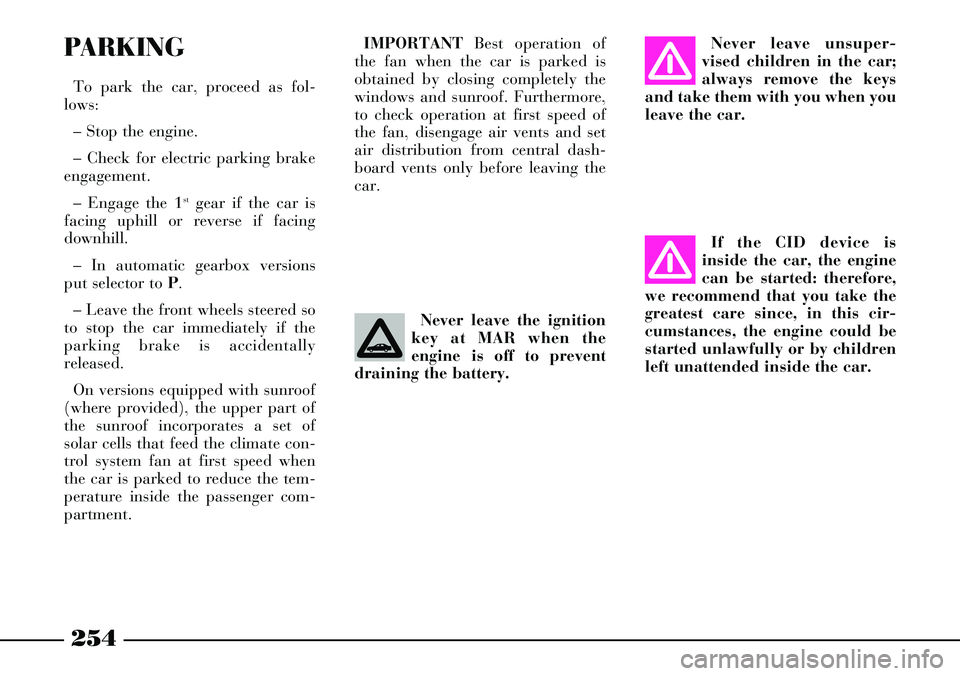check engine Lancia Thesis 2006 Owner handbook (in English)
[x] Cancel search | Manufacturer: LANCIA, Model Year: 2006, Model line: Thesis, Model: Lancia Thesis 2006Pages: 386, PDF Size: 8.69 MB
Page 189 of 386

188
If the failure is signalled when the
engine is started, it means that the
electronic control unit had stored it
previously, before stopping the
engine. Even in this case, go to a
Lancia Dealershipto have the
automatic gearbox checked.
When driving with auto-
matic gearbox faulty,
drive carefully consider-
ing the limited car efficiency in
terms of acceleration and speed.
In addition, when driving with
automatic gearbox faulty, the
reverse block might not be oper-
ating: for this reason it is
absolutely necessary to move the
lever to position R while the car
is moving.SOUND SIGNAL
A buzzer will sound in the follow-
ing conditions:
– for about 15 seconds when the
driver’s door is opened while the
engine is running or not and the gear
lever has a position different from P
– for about 15 seconds when the
engine is turned off and the gear
lever has a position different from P
– for about 4 seconds when the
gear lever is shifted to R(reverse)
– with the manual sequential oper-
ation on, when the selected gear is
not accepted by the electronic con-
trol unit (e.g. since it might generate
a runaway speed rate). BUMP STARTING
Never bump starting the engine (by
pushing, towing, etc.). In an emer-
gency, when the battery is flat, start
the engine with the appropriate
emergency battery according to the
instructions contained in chapter “In
an emergency”.
Page 192 of 386

191
To make ESP, ASR and
ABS systems work prop-
erly, the tyres must
absolutely be of the same brand
and type on all wheels, in perfect
conditions and, above all, of type,
brand and size specified. stantly changed and controlled in
the attempt to keep the driver’s
direction.
The ESP system considerably
increases the car safety in several
critical conditions and it is particu-
larly useful during overtaking, when
the grip conditions on the road bed
change.ASR FUNCTION (ANTISLIP
REGULATION)
General
The ASR function is part of the
ESP system and it checks the car
drive, taking action every time one
or both driving wheels slip, thus pre-
venting car instability and tyre wear.
On the basis of slipping conditions,
two different check systems are acti-
vated:
– if slipping affects both driving
wheels, as a result of the excessive
force transmitted, the ASR function
reduces the power supplied by the
engine;
– if slipping affects only one of the
driving wheels, the ASR function
automatically brakes the slipping
wheel, with an effect similar to the
self-locking differential.The action of the ASR function is
particularly useful in the following
conditions:
– internal wheel slipping when cor-
nering due to load dynamic varia-
tions and excessive acceleration;
– excessive power supplied to
wheels according to the road bed;
– acceleration on slippery ground,
covered with snow or ice;
– in case of grip loss on wet ground
(aquaplaning).
ASR function activation
The ASR function is activated
automatically whenever the engine
is started.
During driving it is possible to dis-
engage and engage this function by
pressing button A(fig. 142) on the
central console.
When the ASR function is on, sym-
bol Vis lighted on the multifunc-
tion display together with the mes-
sage “ASR ON”.
Page 194 of 386

193
The following table summarizes warning light indications according to the different operating conditions.
Operating or failure conditions
Engine start up (key turned to MAR)
Driving in
normal
conditions
Driving inconditions which
might lead to
slipping
ASR fault
ESP fault
System condition
Warning light check
ASR on
ESP on
ASR off
ESP on
ASR active
ESP active
ASR off
ESP active
ASR and ESP off
ASR on
ESP off ASR on
ASR off
manually
ASR on
ASR off
manuallyASR button warning light
On for about 3 seconds
Off
On
Off
On
On
OffESP warning light on
instrument panel
On for about 4 seconds
Off
Off
Flashing
Flashing
On
On
INITIALISING THE ESP SYSTEM CONTROL UNIT
Whenever the battery is electrically connected again or it is reloaded after being completely flat or after replacing one of
the protection fuses, to restore the correct operation of the ESP system, of the door locking, and of the air conditioning, it
is necessary to perform the initialisation operations contained in the paragraph “If battery is to be disconnected” in the chap-
ter “In an emergency”.
Page 212 of 386

211
Obstacles placed in side areas are
detected at a distance of less than
0.6 m.
Rear sensors are automatically
switched on by removing the trailer
cable plug.FAULT INDICATIONS
The system control unit checks all
the system components every time
the ignition key is turned to MAR.
Then, the sensors and their respec-
tive electrical connections are con-
stantly monitored during system
operation.
Parking assist system faults are sig-
nalled by the lighting of symbol t
on the multifunction display, togeth-
er with message “PARKING SEN-
SOR FAULT”.
In case of fault signals, stop the
car, shut the engine off, then try to
clean the sensors, making sure that
you are not close to ultrasound-
emitting sources (e.g. truck air
brakes or pneumatic hammers). If
the cause of the operation anomaly
has been remedied, the system fully
resumes its functions and the fault
symbol on the multifunction display
goes out, together with its respective
warning message. Rear sensors are auto-
matically switched off
when the trailer’s electric
cable plug is inserted into the car
tow hitch socket.TOWING A TRAILER
Page 213 of 386

212
If, on the contrary, the warning
lamp remains on, go to a Lancia
Dealership to have the system
checked even if the system keeps on
working. In fact, if the fault detected
by the control unit does not affect
the operation of the system, the lat-
ter keeps on working and the mal-
function is stored in the memory so
as to be detected by the Lancia
Dealership during a subsequent
check.
GENERAL NOTES
When parking your car, always pay
the greatest attention to the obsta-
cles that could be situated above or
below the sensors. In fact, objects
situated at close range in the car’s
front or rear parts could, under cer-
tain circumstances, not be detected
by the system and, therefore, dam-
age your car or be damaged them-
selves.Moreover, signals sent by the sen-
sors can be altered by damaged sen-
sors, by accumulation of dirt, snow
or ice on the sensors, or by ultra-
sound systems (e.g. truck air brakes
or pneumatic hammers) being oper-
ated nearby.INTERIOR
EQUIPMENT
FRONT CEILING LIGHT
(fig. 159)
This ceiling light includes a central
light and two courtesy lights.
To switch the central light on man-
ually, press button A; to switch it
off, press the same button again.
The light will light up and go out
gradually. If the ceiling light has
been switched on by means of the
button, it will automatically go out
after about 15 minutes after the
engine has been shut off (by turning
key to STOP).
fig. 159
L0A0098b
Page 239 of 386

238
If repairs need to be car-
ried out inside the engine
compartment when this is
still hot, be careful not to burn
yourself and keep away from the
electric fan as this may cut in at
any time, even if the key is
removed from the ignition switch.
Wait until the engine has cooled.
Scarves, ties and other
loose articles of clothing
could easily get caught up
in moving parts.To close the bonnet:
Lower the bonnet at approx. 20 cm
from the engine compartment and
then let it drop, ensuring that it is
fully closed and not just held in posi-
tion by the safety catch. If the bonnet
does not close properly do not push it
down but open it again and repeat the
above procedure.
For safety reasons the
bonnet shall always be
perfectly closed when trav-
elling. Always check for proper
bonnet locking. If the bonnet is left
inadvertently open, stop the car
immediately and close the bonnet.FUEL FILLER CAP
The fuel filler cap flap is controlled
automatically controlled by the cen-
tral door locking system.
When central door locking is on,
the fuel filler flap cannot be opened;
when central door locking is off, the
flap can be opened by simply press-
ing on the front part in point A(fig.
215).
Open the fuel filler flap by turning
it in the direction shown by the
arrow until it is completely opened.
fig. 215
L0A0012b
Page 246 of 386

245
EOBD SYSTEM
The EOBD (European On Board
Diagnosis) system continuously
monitors the engine emission system
components. Furthermore, the sys-
tem warns the driver of deterioration
concerning the emission system
components by means of the instru-
ment panel warning light Ucoming
on with message “ENGINE CON-
TROL SYSTEM FAULT”.The objective is to:
– monitor system efficiency;
– warn when failures can increase
emissions over the threshold estab-
lished by the European regulations;
– warn of the need to replace dete-
riorated components.
Furthermore, the system is
equipped with a connector for inter-
facing with specific tools used to
read the error codes stored in the
control unit memory along with a set
of diagnostic and engine specific
parameters. This check can also be
performed by traffic controller
agents.Contact a Lancia
Dealership as soon as
possible if the instrument
panel Uwarning light either
does not come on when the key is
turned to MAR or comes on, with
fixed or flashing light, when trav-
elling together with message
“ENGINE CONTROL SYSTEM
FAULT”. Warning light Uoper-
ation can be checked by traffic
controller agents. Comply with
the regulations in force in the
country where you are travelling.
IMPORTANTAfter eliminating
the problem, your Lancia
Dealershipwill run a bench test to
fully check the system. In some
cases, a long road test may be
required.
Page 248 of 386

247
The car is fitted with an
electronic brake force
distributor (EBD). The x
and >warning lights come on at
the same time on the multifunc-
tion display, together with mes-
sage “EBD SYSTEM FAULT”,
when the engine is running to
indicate that there is an EBD sys-
tem failure. In this case violent
braking may be accompanied by
early rear wheel locking with the
possibility of skidding. Drive the
car extremely carefully to the
nearest Lancia Dealership to
have the system checked.
If warning light x
comes on together with
message “LOW BRAKE
FLUID LEVEL”, on the multi-
function display, stop the car
immediately and contact a Lancia
Dealership. Fluid leakage will
compromise efficiency of both the
traditional brake system and the
ABS system.The system performance
in terms of active safety
must not lead the driver
to take unnecessary or unjusti-
fied risks. Always suit your dri-
ving style to the weather, visibili-
ty and traffic conditions.
Excessive use of engine
braking (gears tooshort
and limited grip) may
make the wheels slip. The ABS
will have no effect on this type of
skidding.
The maximum possible
deceleration always
depends on the available
road grip. Obviously, grip will be
considerably decreased in the
presence of snow and ice. In these
conditions, the braking space
will still be high, even with the
ABS.The coming on of the
>warning light on the
multifunction display,
together with message “ABS SYS-
TEM FAULT”, when the engine is
running, normally indicates a
fault in the ABS system. In this
case the braking system will still
be effective although without the
anti-lock device assistance. In
these conditions, EBD system
operation may also be reduced.
Drive the car extremely carefully
to the nearest Lancia Dealership
to have the ABS system checked.
Page 254 of 386

253
Remember that until the
engine has started, the
brake booster and power
steering systems will not work
and a greater effort will therefore
be required to press the brake
pedal and turn the steering
wheel. For cars equipped with
turbosupercharger in
particular, but generally
for any kind of cars, avoid abrupt
accelerations immediately before
turning the engine off. A quick
burst on the accelerator serves
absolutely no practical purpose,
wastes fuel and may damage seri-
ously the turbosupercharger
rotor bearings.EMERGENCY START-UP
If the Lancia CODE system fails to
recognise that code transmitted by
the ignition key (symbol Ytogeth-
er with message “VEHICLE PRO-
TECTION SYSTEM FAULT” on the
multifunction display) the emer-
gency start-up can be performed by
using the CODE card code.
For the correct procedure see chap-
ter “In an emergency”.
Before opening the lug-
gage compartment bonnet
to reload the battery or to
connect an auxiliary battery,
carefully read and comply with
the instructions contained in the
paragraph “If battery is to be dis-
connected” in the chapter “In an
emergency”. Never bump start the
engine (by pushing, tow-
ing or coasting downhill)
as this could cause fuel to flow
into the catalytic exhaust system
and damage it beyond repair.
IMPORTANTIf the engine turns
off while the car is running, the
Lancia CODE symbol Yand the
message “VEHICLE PROTECTION
SYSTEM FAULT” may appear on
the multifunction display when the
engine starts again. In this case
check that the warning light switch-
es off when turning the engine off
and on again with the car stationary.
Otherwise contact aLancia
Dealership.
Page 255 of 386

254
Never leave unsuper-
vised children in the car;
always remove the keys
and take them with you when you
leave the car.
If the CID device is
inside the car, the engine
can be started: therefore,
we recommend that you take the
greatest care since, in this cir-
cumstances, the engine could be
started unlawfully or by children
left unattended inside the car.PARKING
To park the car, proceed as fol-
lows:
– Stop the engine.
– Check for electric parking brake
engagement.
– Engage the 1
stgear if the car is
facing uphill or reverse if facing
downhill.
– In automatic gearbox versions
put selector to P.
– Leave the front wheels steered so
to stop the car immediately if the
parking brake is accidentally
released.
On versions equipped with sunroof
(where provided), the upper part of
the sunroof incorporates a set of
solar cells that feed the climate con-
trol system fan at first speed when
the car is parked to reduce the tem-
perature inside the passenger com-
partment.Never leave the ignition
key at MAR when the
engine is off to prevent
draining the battery.
IMPORTANT Best operation of
the fan when the car is parked is
obtained by closing completely the
windows and sunroof. Furthermore,
to check operation at first speed of
the fan, disengage air vents and set
air distribution from central dash-
board vents only before leaving the
car.